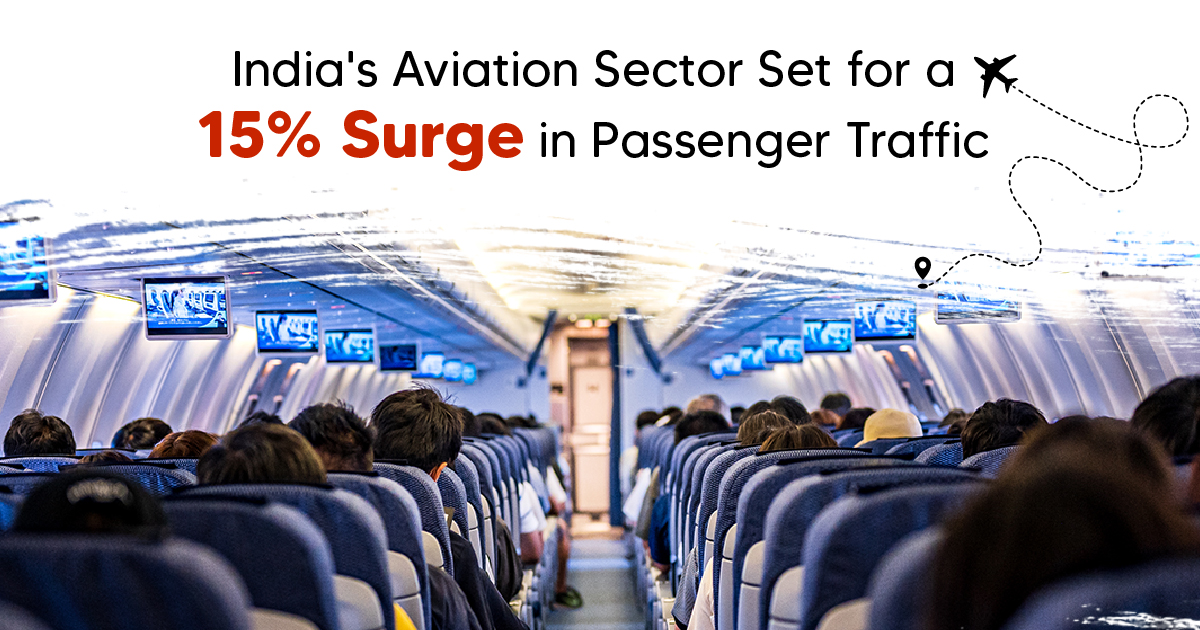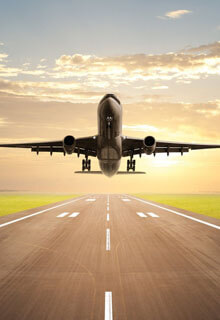India’s Aviation Sector Set for a 15% Surge in Passenger Traffic
India’s aviation sector is not merely taking off. It is soaring to new heights with a projected 15% surge in passenger traffic. This impressive growth is a testament to the resilient spirit of the industry. A combination of soaring demand and the government’s commitment to promoting a conducive environment fuels the growth. Also, the rise in Elite Clients in Aviation Services is helping in the surge in passenger traffic. It is time to take a look at the factors that have helped the aviation sector to grow in a big way in India.
Proactive Infrastructure Development
In the past nine years, India’s aviation infrastructure has undergone a transformative expansion. This is helping in propelling the nation into the ranks of the world’s top aviation markets. The government’s visionary policies and initiatives have played a pivotal role in this growth. This in turn is resulting in the doubling of operational airports from 74 in 2014 to an impressive 148 in April 2023.
Regional Connectivity Scheme – UDAN (RCS-UDAN): A Game-Changer
Central to this growth is the Regional Connectivity Scheme-Ude Desh ka Aam Nagrik (RCS-UDAN). This innovative initiative aims to provide connectivity to previously unserved and underserved airports across the country. By reviving existing airstrips and airports, RCS-UDAN is not just connecting regions. It is also creating a platform for economic development.
Delhi and Mumbai airports have set a precedent by achieving Level 4+ Carbon Accreditation. This showcases a commitment to sustainability. Also, this achievement is a significant stride towards reducing the carbon footprint of the aviation sector. It aligns with global environmental goals.
RCS-UDAN: Connecting the Unconnected
The RCS-UDAN scheme has evolved into a dynamic force, breathing life into the civil aviation industry. In the last six years, four new and successful airlines have emerged. All this is fostering healthy competition. This scheme has not only enabled the initiation of airline operations. But it has also provided smaller regional airlines with the opportunity to scale up their businesses.
Progress Update (As of December 04, 2023)
- For airport development under RCS-UDAN, a substantial ₹4500 Crores was allocated.
- Operational success with 517 RCS routes connecting 76 airports, including 9 Heliports and 2 Water Aerodromes.
- Over 1.30 crore people have directly benefitted from the scheme’s efforts.
- An encouraging ₹1000 Crore was allocated in the Budget 2023-24. This is for the revival and development of an additional 50 aerodromes.
Passenger Growth Takes Flight
The aviation sector’s remarkable resurgence post-Covid is driven by an unprecedented surge in passenger demand. From January to September 2023, domestic airlines experienced a substantial 29.10% increase. These airlines carried 112.86 million passengers compared to 87.42 million during the same period in 2022. Furthermore, there has been a rise in char dham yatra by helicopter in the past few years. Additionally, international travel has witnessed an even more impressive uptick, with a 39.61% increase in passengers during the corresponding period. There was a 39.61% increase in passengers during the corresponding period.
Carbon Neutrality Initiatives
The Ministry of Civil Aviation (MoCA) is leading the charge towards carbon neutrality. It is setting ambitious targets for airports in the country. Moreover, it is standardizing the Carbon Accounting and Reporting framework. By doing this MoCA encourages airport operators to map and gradually reduce carbon emissions, aiming for net-zero emissions.
Delhi, Mumbai, Hyderabad, and Bengaluru airports stand out as pioneers, achieving Level 4+ ACI Accreditation and becoming carbon neutral. Furthermore, an encouraging 66 Indian airports operate entirely on 100% Green Energy. This underlines India’s commitment to sustainable aviation practices.
Projected Growth: 15% Surge in Passenger Traffic
Despite challenges, India’s air traffic is set to surge by 15%. It is expected to reach 155 million passengers in 2023-24. The use of private jet charter services is also expected to rise in the coming years. This projection aligns with CAPA India’s estimate. The report showcases the industry’s resilience in the face of obstacles like the grounding of Go First and supply chain issues.
Industry Outlook
India’s international air traffic is expected to reach approximately 70 million passengers by the end of the year. The overall industry may incur a projected loss of USD 1.648 billion. But there are noteworthy exceptions. IndiGo, despite facing operational challenges, is forecasted to post a record profit of USD 500 million. This is a testimony to its resilience and strategic management.
Air India Group, on the other hand, is on a growth trajectory. It has plans to add over 60 aircraft by the end of the financial year. This expansion includes 30 for Air India, 20 for Air India Express, and 10+ for Vistara, bringing the total fleet close to 300 aircraft.
However, the industry faces operational constraints. Only 588 out of the projected 789 aircraft are expected to be operational by the end of the year. In response, airlines such as IndiGo and SpiceJet are resorting to inducting aircraft on wet leases to bridge the shortfall in capacity. Additionally, private jet charter services are also playing a role in meeting the surge in passengers.
On Ticket Prices and Normalization
Despite challenges, domestic and international fares are gradually normalizing from post-pandemic highs. This normalization is occurring despite shortages in the number of operational aircraft. This indicates a robust market adapting to the evolving dynamics of the aviation sector.
The Rise in the Elite Class:
Moreover, the increase in the presence of Elite Clients in Aviation Services is also responsible for the surge in passenger traffic. As the country’s economy experiences growth and globalization, there has been a rise in demand for premium aviation services. These high-net-worth individuals, business executives, and celebrities are seeking convenience. They also want personalized and luxurious travel experiences.
Private jet charters, exclusive airport lounges, and bespoke in-flight services are gaining popularity among elite clients. These people value time efficiency, privacy, and a seamless travel experience. The demand for executive jets and premium-class services has led to innovations in the aviation industry. Airlines and private aviation companies are investing in state-of-the-art aircraft and enhanced amenities. This is to cater to the elevated expectations of their elite passengers.
Furthermore, the surge in elite clients has contributed significantly to the growth of luxury travel and tourism. As a result, this has also given a boost to the aviation sector. Megamax Aviation which offers char dham yatra by helicopter provides the best services to the elite class.
Conclusion:
India’s aviation sector is not just a mode of transportation. It is a dynamic and evolving force. The 15% surge in passenger traffic is not merely a statistic. It shows the industry’s resilience, adaptability, and potential on the global stage. The government continues its proactive approach, and the industry navigates challenges in the best possible ways.



